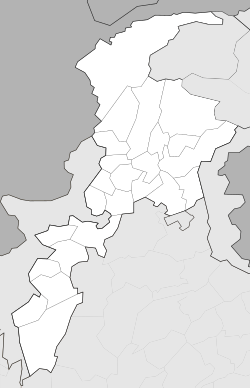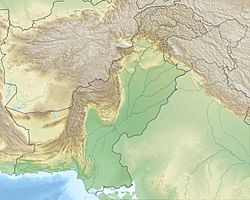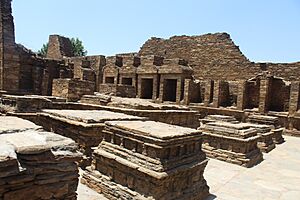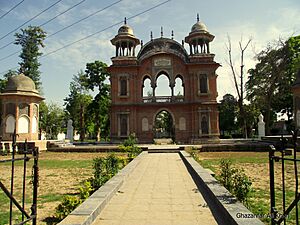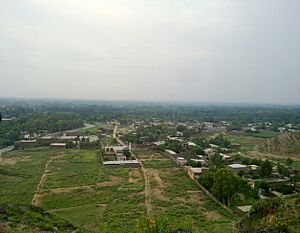Mardan facts for kids
Quick facts for kids
Mardan
مردان
|
|
|---|---|
|
City
|
|
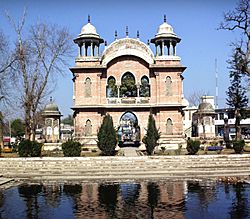
Mardan's Guides Memorial was built in 1892 to honour fallen soldiers who fought during the 1879 Siege of the British Residency in Kabul
|
|
| Country | |
| Province | |
| District | Mardan |
| Tehsil | Mardan |
| Government | |
| • Type | Mayor-council |
| • Body | District Government |
| Elevation | 310 m (1,020 ft) |
| Population
(2017)
|
|
| • City | 404,436 |
| • Rank | 23rd, Pakistan 2nd, Khyber Pakhtunkhwa |
| Mardan Municipal Committee: 391,733 Mardan Cantonment: 6,871 |
|
| Time zone | UTC+5 (PST) |
| Calling code | +92 937 |
Mardan is a city in the Khyber Pakhtunkhwa Province of Pakistan. It is located in the Valley of Peshawar. Mardan is the second-largest city in Khyber Pakhtunkhwa, right after Peshawar. It's a city that has grown very quickly, especially in the last half of the 1900s.
Around 1800 BCE, the area where Mardan is now was home to the Gandhara grave culture. You can still see ancient rock carvings, called Edicts of Ashoka, in nearby Shahbaz Garhi. These carvings were made by the ancient Indian King Ashoka around 250 BCE. They are written in the old Kharosthi script and are the earliest clear proof of writing in South Asia. Also, the ancient Buddhist monastery of Takht-i-Bahi is nearby and became a UNESCO World Heritage Site in 1980.
Contents
History of Mardan
| Historical Population | ||
|---|---|---|
| Year | Pop. | ±% p.a. |
| 1951 | 48,827 | — |
| 1961 | 77,932 | +4.79% |
| 1972 | 115,194 | +3.62% |
| 1981 | 147,977 | +2.82% |
| 1998 | 245,926 | +3.03% |
| 2017 | 358,604 | +2.01% |
The area around Mardan is full of amazing old sites. In 1962, the Sanghao Caves were found just outside Mardan. Inside, scientists found tools and items from over 30,000 years ago! Other nearby places also show signs of human activity from even older times.
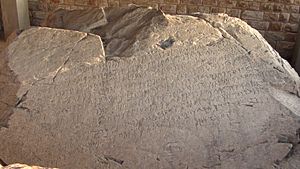
Around 1800 BCE, the Gandhara grave culture lived in this region. This group might have come from Central Asia. Later, Mardan became part of the ancient Buddhist kingdom of Gandhara. The famous Edicts of Ashoka were carved into rocks in nearby Shahbaz Garhi around 250 BCE. These writings are in the ancient Kharosthi script.
The Takht-i-Bahi monastery, a UNESCO World Heritage Site, was built around 46 CE. In 1891, the Bakhshali manuscript was found near Mardan. This old book, from the 3rd or 4th century CE, is important because it has the earliest record of the number zero being used in the Indian subcontinent. The nearby Kashmir Smast caves were used by Buddhist monks from the 4th to 9th centuries CE.
During the Sepoy Mutiny of 1857, Mardan did not see much fighting. Many local soldiers had already given up their weapons to the British. Mardan's famous Guides' Memorial was built in 1892. It honors soldiers who died fighting in the 1879 Siege of the British Residency in Kabul. The city's Women's Hospital opened in 1906. The Mardan Museum was created in 1991 to show off the region's rich ancient history.
In July 2020, life-sized statues of the Buddha were found during construction in Mardan. These findings are part of the area's ancient Buddhist past.
People of Mardan (Demographics)
Mardan is a main center for the Yousafzai tribe of Pashtuns. Many people from the Mohmand, Utmankhel, Tareen, and Khalil tribes have also moved to the city over the years.
According to the 2023 Census of Pakistan, Mardan city had 404,436 people living there. This makes it the second-largest city in Khyber Pakhtunkhwa. These people lived in 51,429 homes, with about 7.89 people per home. Mardan grew very fast in the late 1900s, with its population increasing five times in 50 years. However, its growth has slowed down more recently.
Education in Mardan
For a long time, Mardan did not have its own university. But in 2009, the first public university, Abdul Wali Khan University Mardan, was opened. Later, in 2016, the Women University Mardan started. In 2017, the Mardan campus of the University of Engineering and Technology, Peshawar became its own full university, now called University of Engineering and Technology, Mardan.
Bacha Khan Medical College, established in 2010, is the city's only medical college. There is also a campus of the University of Agriculture, Peshawar, called Agriculture University Ameer Mohammad Khan Campus Mardan.
Mardan also has two postgraduate colleges, one for boys and one for girls. Government Post Graduate College Mardan opened in 1952, and Government Post Graduate College for Women Mardan opened in 1963. Many other public and private schools and colleges for boys and girls are in Mardan, with Fazal e Haq Mardan being one of the most well-known.
Geography of Mardan
Mardan is located in the southwest part of its district. It sits at an elevation of about 283 meters (928 feet) above sea level. Mardan is the main city of the Mardan District in Khyber Pakhtunkhwa. Nearby towns include Risalpur to the south, Charsadda to the west, Yar Hussain to the east, and Takht Bahi & Katlang to the north. It is the second-largest city in Khyber Pakhtunkhwa and the 19th largest city in Pakistan.
Mardan's Climate
Mardan has a hot, semi-arid climate. This means it's generally dry with hot summers. The average temperature in Mardan is about 22.2°C (72°F). The city gets about 559 mm (22 inches) of rain each year. October is the driest month, while August is the wettest, with about 122 mm (4.8 inches) of rain.
June is the hottest month, with an average temperature of 33.2°C (91.8°F). January is the coldest month, with an average temperature of 10.0°C (50.0°F).
| Climate data for Mardan | |||||||||||||
|---|---|---|---|---|---|---|---|---|---|---|---|---|---|
| Month | Jan | Feb | Mar | Apr | May | Jun | Jul | Aug | Sep | Oct | Nov | Dec | Year |
| Mean daily maximum °C (°F) | 17.7 (63.9) |
19.0 (66.2) |
24.0 (75.2) |
30.1 (86.2) |
36.3 (97.3) |
41.4 (106.5) |
38.5 (101.3) |
36.5 (97.7) |
35.3 (95.5) |
31.6 (88.9) |
25.1 (77.2) |
19.4 (66.9) |
29.6 (85.2) |
| Daily mean °C (°F) | 10.0 (50.0) |
12.2 (54.0) |
17.2 (63.0) |
22.7 (72.9) |
28.2 (82.8) |
33.2 (91.8) |
32.3 (90.1) |
31.0 (87.8) |
28.8 (83.8) |
23.2 (73.8) |
16.2 (61.2) |
11.0 (51.8) |
22.2 (71.9) |
| Mean daily minimum °C (°F) | 2.3 (36.1) |
5.5 (41.9) |
10.4 (50.7) |
15.3 (59.5) |
20.2 (68.4) |
25.1 (77.2) |
26.2 (79.2) |
25.5 (77.9) |
22.3 (72.1) |
14.9 (58.8) |
7.4 (45.3) |
2.7 (36.9) |
14.8 (58.7) |
| Average precipitation mm (inches) | 47 (1.9) |
53 (2.1) |
67 (2.6) |
44 (1.7) |
20 (0.8) |
17 (0.7) |
88 (3.5) |
122 (4.8) |
45 (1.8) |
12 (0.5) |
14 (0.6) |
30 (1.2) |
559 (22.2) |
| Source: Climate-Data.org | |||||||||||||
Mardan's Economy
Mardan is becoming an important industrial area. It has factories that make textiles (like cloth) and edible oils. It's also home to one of the biggest sugar mills in South Asia. A new economic zone is being planned near Rashakai as part of the huge China-Pakistan Economic Corridor (CPEC) project. Even though Rashakai is in a different district, this new zone is expected to bring many benefits to Mardan.
Sports in Mardan
In 2006, the Mardan District government, with help from the Government of Pakistan, built a sports complex in Mardan city. This complex, called Mardan Sports Complex, has places for many popular sports. You can find facilities for cricket, football, field hockey, swimming, and basketball. A swimming pool was added in 2011, and an international-standard hockey field was built in 2016.
Some famous international athletes come from Mardan. Mansoor Khan is a Pakistan international football player from Mardan. Well-known international cricketers like Younis Khan, Fakhar Zaman, and Naseem Shah were also born in Mardan.
Images for kids
-
The Seated Buddha, dating from 300 to 500 CE, was found near Mardan, and is now on display at the Asian Art Museum in San Francisco.
See also
 In Spanish: Mardan para niños
In Spanish: Mardan para niños


